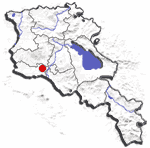Article about Echmiadzin, July 2013
Tour guide to Echmiadzin, RECEA Center
Zvarnots, a complex construction with antique tradition, is situated between Yerevan and Echmiadzin and was built around the middle of the 7th century. The construction consists of St. George’s Church, also called “Zvarnots”, which means heavenly guards or angels, and the palace of the builder, Katholikos Nerses III. Zvarnots, built between 641 and 661 would exceed the church of Echmiadzin in significance and dimensions.
Already in the beginning of the 10th century the construction was destroyed. There is no cause known. What remained were the foundation walls, columns, and some more single fragments. Today’s try of a reconstruction leads to different results about the original look of the construction.
The construction stayed hidden until the beginning of the 20th century. The excavations were made between 1901 and 1907. The base of the cathedral, the remains of the bishop’s palace and a wine cellar were digged up. Furthermore during the excavations it showed up that Zvarnots was built on remains and structures which go back in times of the Urartians.
The remains of Zvarnots, also as ruins, are still imposing. There only remained the lower parts of the walls and single fragmentations. The views about the original state differ.
 |
| Remains of Zvarnots cathedral; source: Wikipedia |
Zvarnots was built in a time when already a big part of Armenia was under the influence of Byzance and the first attacks of Muslim Arabs were happening. This fact might not have been without consequences on the formation of the construction.
There is no clear view about the original formation of the cathedral. Most likely accepted is the idea of Toros Toramanian who was immediately involved in the excavations in 1905. According to this the building had three floors. The inside of the church had a mosaique in the form of a greek cross which was defined by a passage. The outer form was the one of a building with 32 edges, so at last round.
Together with the churches of Echmiadzin Zvarnots was added to the list of UNESCO’s world cultural heritage in year 2000. A picture of the cathedral was represented on the first 100 Dram bank notes and a model can be visited today in the Museum for History in Eriwan.
Between 643 and 652 Katholikos Nerses III. (called “The Builder”) built the cathedral of St. George in a place where there was supposed to be a meeting of King Trdat III. and Gregory the Illuminator. In 930 the church was destroyed by an earthquake and was just rediscovered in the 20th century. Excavations between 1900 and 1907 exposed the foundations of the cathedral and the remains of the Palace of Katholikos and of one winery.
In the last years, some of the walls and columns with capitells and arcs were set up again and were partly supplemented by reconstructions.
The inside of the palace church, decorated with frescos, used to have the form of a greek cross with three axes, however, the outer form was a 32 sided polygon that appears as a circle from far away.
Today’s academics agree with the conclusion of Toros Toramanjan, who collaborated in the excavations, that the building used to have three floors.
Some sources assert that the cathedral is displayed standing on the Ararat mountain in one of the frescos in the Sainte-Chapelle in Paris. But this is not very probable because this fresco arose only after more than 300 years after the destruction of the church.
Together with the churches of Echmiadzin and the monasteries of Haghpat and Sanahin in the north of Armenia, in year 2000, Swarnoz was included in the UNESCO world heritage list.
A drawing of the cathedral is pictured on the first edition of the Armenian 100 Dram bank note and a model of the cathedral can be visited in the Historical museum in Yerevan. The ruins of Swarnots are a popular film set. For instance, there were scenes of the opera adaptation “Norma” captured.
The cathedral of Echmiadyzin (Mayr Tajar Surb Etschmiadsin; originally known as mother of God’s church) is an Armenian apostolic church in the Armenian province Armawir. It is part of a monastery construction and cathedral of the patriarch of the Armenian apostolic church, the catholicos of the Holy See of St. Echmiadzin and all Armenians. The church that was founded from 301 on the basements of a hagan temple was finished in August 303 from the first catholicos, Gregor the Illuminator. Since 2000 it is listed as UNESCO world cultural heritage. In the cathedral there is a museum in which relics and treasures are exposed.
The cathedral of Echmiadzin, that is situated about 20 km west of Yerevan, is the oldest christian place of Armenia and represents the religious center of this country until today. It is considered to be the first christian church built from a state and was in the times of the Soviet Union the oldest church in their territorium. The cathedral is one of the most important monuments of Armenia.
 |
| Echmiadzin; source: Wikipedia |
Echmiadzin museum
You shouldn't leave Echmiadzin, before entering the Manougian museum. It contains plenty of memories, pious art products and lightened manuscripts, so insist on seeing it. Another secret is a fire pit below the altar. This is where hagans prayed to fire before the Christianity. It is in the small museum in the main cathedral, with the entrance on the right side of the altar.
There are some pious art products in possession but usually You have to ask for showing the prayer’s pit to You for a little donation.
No comments:
Post a Comment